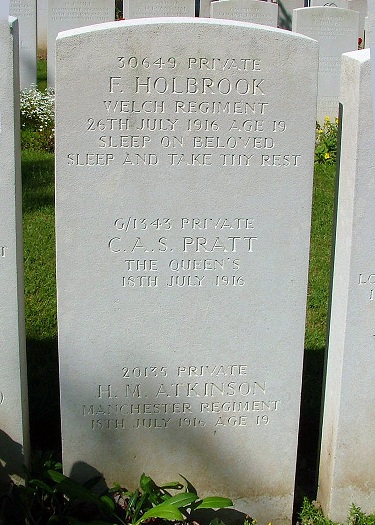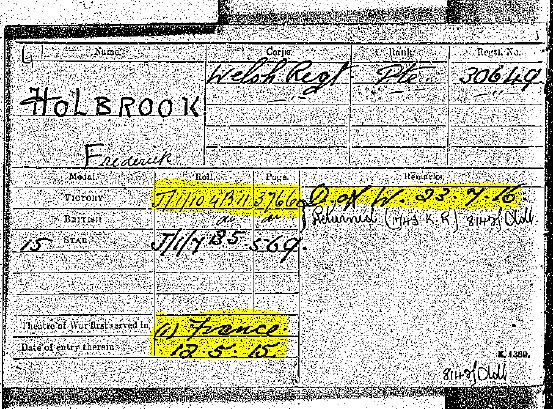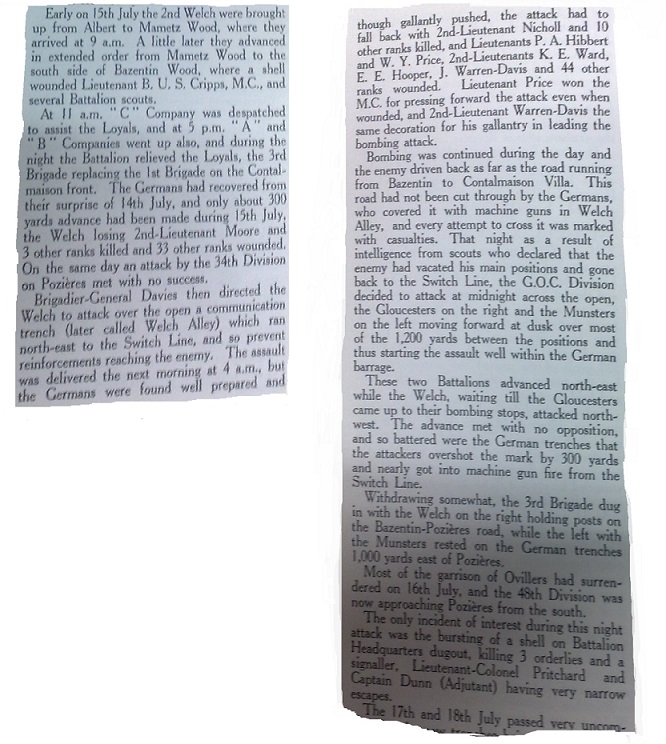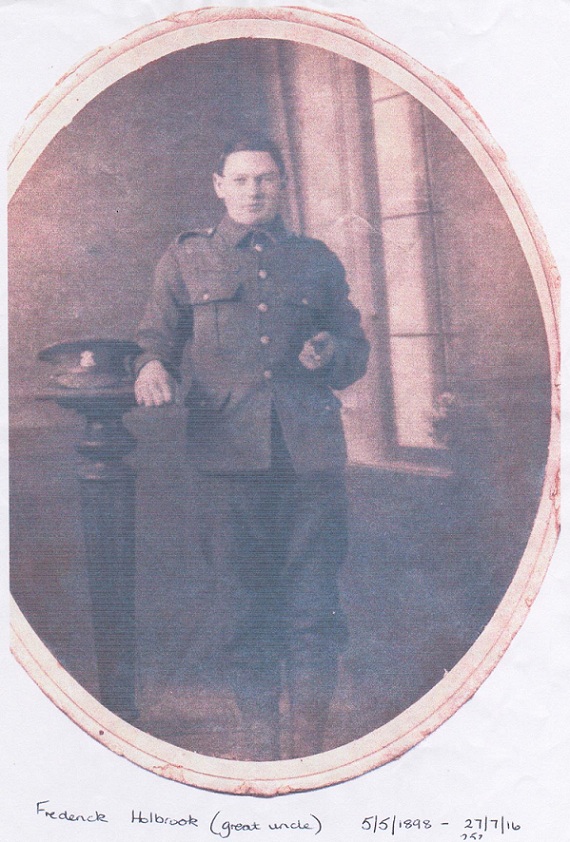My introduction to First World War research didn’t initially come through looking into my own family. One of my hobbies is bellringing: like so many clubs and social groups the Central Council for Church Bell Ringers created its own roll of honour after the First World War. Much work has been done in recent years to link the names on the roll with Commonwealth War Grave Commission records, but some names were proving stubborn, and there didn’t seem to be any obvious candidate. I realised that I was in a position to help since I could easily look at the available records.
It soon became clear that at least some of the men had been overlooked at the time, their health had broken under the strain of army service and had been discharged as a result, and subsequently died from the same condition. While they qualify for recognition under the terms of CWGC’s royal charter, their names had never been put forward for inclusion on the debt of honour register. I wrote up as much detail as I could find on these men on our old Your Archives wiki (see for example Gilbert Victor Drew) and with help from members of the Great War Forum and the In From the Cold Project I was able to get a few men added to the CWGC register.
So, having already honed my research skills to some extent, I then received an email via my Dad from his cousin Jane who had been working on the family history. In particular she was looking for help with her great-uncle (my great-great-uncle), Frederick John Holbrook. She had already found his entry in the CWGC database and his medal index card (WO 372/9/241037). This showed that he had served in 2nd Battalion, Welsh Regiment as Private 30649. 1
They also reveal one slight discrepancy, with CWGC showing his date of death as 26 July 1916 and the medal card as 23 July. Another discrepancy is that CWGC record his age as 19, but Births, Marriages and Deaths records show that he was born on 5 May 1898, 2 meaning he was just 18 when he died: and since the medal card also shows that he was posted to France on 12 May 1915 he must have been underage when he joined up. Certainly he looks very young in the surviving photo of him, and rather swamped by his uniform.
From the available information so far, there were a few obvious next steps. Firstly, the information from the CWGC shows his battalion (not often shown on medal cards). This allows us to find the relevant war diary, in WO 95/1281 (not yet digitised for download at the time of writing, and certainly not when I was originally looking). While I was waiting to have a lunchtime when I could fit in a look at the diary, I used the other information in the catalogue entry to get a quick overview of what the battalion had been through. It shows that the battalion was in 3 Infantry Brigade, part of 1st Division. A useful way to get a quick overview of what a particular unit was up to is to use Chris Baker’s website, The Long, Long Trail (it’s undergoing a bit of a revamp at the moment, so some of the following links may break). Here you can find a a brief overview of the service of all battalions of the Welsh Regiment, and similar information about the activities of 1st Division. The divisional information also links to descriptions of each of the major battles in which it participated during the course of the war. From this information we can deduce that Fred was probably posted to France in response to the losses sustained by 2nd Welsh at the Battle of Aubers, 256 officers and men were lost on 9 May, somewhat over 25% of the battalion’s full strength (in reality they were unlikely to have been at strength to start with). Looking at major operations, he would then have been involved in the Battle of Loos in September 1915 (where the battalion lost 311 men), and in the immediate run-up to his death, the opening phases of the Battle of the Somme from 1 July 1916.

Grave of Privates Frederick Holbrook, C A S Pratt and HM Atkinson; courtesy of the War Graves Photographic Project and their volunteers Peter Magnall and David Milborrow (their copyright)
The war diary filled in more detail of day-to-day life (though as usual, particularly as it was a regular battalion, other ranks like Fred are not mentioned by name). I also found that the library at Kew held the published History of the Welch Regiment (in particular Part ii covers the First World War). By now I was forming a hypothesis as to how Fred might have met his death: in fact as soon as I saw his date of death I guessed his death had been connected with the Battle of the Somme. This idea was strengthened by the CWGC information about the cemetery where Fred now lies, Heilly Station Cemetery, which is in the Somme area. Three Casualty Clearing Stations (hospitals) were based around what is now the cemetery when the Battle of the Somme started, and it was linked by railway almost to the front lines.
I thought that I might also be able to reconcile the two dates for his death as a result of this information. The date on the medal card, 23 July, coincides with when 2nd Welsh were moving up to take part in the Battle of Pozieres (one of the sub-phases of the Somme), it seemed that perhaps he was wounded then, evacuated to one of the Casualty Clearing Stations at Heilly where he succumbed to his wounds on 26 July. In the meantime, Jane had managed to acquire a photo of Fred’s grave via The War Graves Photographic Project, they have kindly granted permission for me to use it in this blog post. Those familiar with the usual run of CWGC headstones will notice that this one (and some of the others which can be seen nearby) bear three names, and do not bear the regimental badge. The cemetery was overwhelmed by casualties from the Somme, and the only way they could keep up with the burials was by putting three men to a grave. This meant that they could not fit the badge for each man on the stone, so they are engraved within a stone pagoda at the entrance to the cemetery. However, the next of kin were still given the opportunity to record a personal inscription for each man, and we can see that for Fred was written, Sleep on beloved, Sleep and take thy rest. A little googling soon found that the words were from a hymn, ‘The Christian’s Good Night‘.

Medal Index Card of Fred Holbrook, WO 372/9/241037. I have highlighted the details used to find information mentioned in this article.
Now seemed an opportune moment to move on to look at the medal roll. The key to finding these are the roll references on the medal card, in this case, for his Victory and British War Medals, the original reference was J/1/104B11, page 3766. All the First World War medal rolls are now in the series WO 329, so it was simply a matter of working out which current catalogue reference corresponds to that original reference. Searching within Discovery with the roll number, welsh regiment and restricted to the reference WO 329 returns only two results, checking the pages numbers (it’s best not to search on these as only ranges are given in the catalogue descriptions) shows that the relevant page is now in WO 329/1318.
Interestingly, the roll shows a few other units than the 2nd battalion – unfortunately, no dates are given. The first posting, to an infantry base depot. is not entirely unexpected. It was usual after the earliest days of the war for men to spend some time at such places before joining a battalion in the field, the idea to give some more specific training in France. Then he joins the 2nd battalion, then for some reason goes back to a base depot (possibly for a training course, or he might have been wounded). Then, most interesting, is an indication that he spent time attached to the Royal Engineers, specifically 26th Field Company which was also part of 1st Division. This immediately suggested I should be looking for a new war diary, and with a field company being a little less than quarter the size of an infantry battalion 3 perhaps a little more chance of an identifiable reference to Fred. However I soon discovered, after trying a number of searches in the catalogue 4, that the only surviving war diary for the company covers only 1 January 1917 to 30 April 1919. To make absolutely sure, I even checked the paper ‘Red Lists’, which for WO 95 also list each unit and the relevant catalogue references. I had heard that the Royal Engineers museum at Chatham held some duplicate copies of war diaries, but it isn’t possible to find out what they hold without visiting the museum itself. Rather in desperation I browsed through the catalogue descriptions relating to war diaries for all units in 1st Division 5 and discovered three war diaries kept by the Commander, Royal Engineers of the division. Of these, WO 95/1245 and WO 95/1246 cover the period during which Fred was serving with division. Having ordered WO 95/1246 (which covers May 1916 to the end of the war), I soon discovered the page shown below.

Message dated 19 May 1916 included as appendix to May war diary, addressed to OC 26th Field Company - I can't be sure Fred was among the 48 men ordered to be attached to the field company, but it seems a pretty good bet! (author's own photo, from Flickr photostream)
Further entries suggest that the purpose of the attachment to the Royal Engineers was to train men as battalion pioneers. This allowed the men to undertake some basic engineering tasks without the assistance of the field company 6, particularly when attacking: for example captured trenches needed to be turned in order to make them defensible against German counterattacks. Often the men selected for this role would have some civilian skill which would be useful – was this the case with Fred? Family history showed that Fred’s father Henry Holbrook had been a bricklayer – he died as the result of an industrial accident at the East Moors Ironworks (also known as the Dowlais Works) 7, had Fred followed in his footsteps, despite the nature of his father’s death? My final question was whether any of this had any bearing on Fred joining the army when he did?
The 1911 census shows the family at the long-term family home at 67 Llanelly Street, Cardiff (some of the family were still living there in the 1960s). Fred’s widowed mother, Ellen, is listed as head of the household, she wasn’t working. Her four surviving children are all present: the eldest, Emily Florance [sic], 15, was working as a general servant domestic; the younger three, Frederick John (12), Arthur Thomas (10) and Henry Ivor (8) were presumably all still at school, so this doesn’t help us to establish if Fred might have followed his father as a brickie. Family lore also suggested that there might have been family involvement in building the house in the first place, so I wanted to investigate the area to understand a little more about it. Looking at modern maps, I soon realised that the street no longer existed. A few web searches turned-up some useful information, such as this Rootsweb thread which explains that the whole East Moors area revolved around the ironworks, with the housing being thrown up quickly when the works moved there from Merthyr Tydfil in the 1880s. It also mentions the Cardiff: the building of a capital project at Glamorgan Archives, using the search facility I entered Holbrook in the ‘Developer’ field, and a screenful of results were returned, mostly for G[eorge] Holbrook (the name of Fred’s grandfather), including several in Llanelly Street. I also followed the steps in the Valuation Office research guide to find some maps and descriptions of Llanelly Street.
One other search result was even more useful, leading me back to the Great War Forum where I discovered a fellow member with a particular interest in Cardiff casualties of the war whose family, it transpired, actually lived next door to mine! He was also able to pass on a few titbits about Fred he had gleaned from the South Wales Daily News published 18 August 1916. Fred had attended Morland Road school, and had indeed worked as a bricklayer at the Dowlais works prior to joining up in February 1915 aged 16. He was wounded on 16 July 1916 (blowing my theory out of the water). This date suggests that his wounds were received in operations connected with the Battle of Bazentin Ridge. This lucky break answered most of the questions I’d posed myself – though his exact motivation for joining up when he did will probably always be a mystery. However, the chance to be paid an adult wage, and to escape the job which had already seen his father killed, must have played their part. 8 I was also passed the information that Fred is commemorated on the war memorial at St Saviour’s (Church in Wales), Splott, and the roll of honour of the Dowlais works, a transcription of which is kept at Cardiff Central Library.
The one remaining discrepancy which it would be nice to resolve once and for all is which date of death is correct. Even in war, death returns had to be made by the army to the General Register Office. I believe Fred’s death certificate is under reference GRO Overseas I.25.49. I’d also like to see the original of the article in the South Wales Daily News and visit some of the bits of Cardiff he would have known – and maybe one day visit his grave myself. To finish, extracts from the History of the Welch Regiment, pp. 391-392 describing the events of 15-16 July 1916. 2nd Battalion, the Welsh Regiment, 16 July 1916.

History of the Welch Regiment, pp. 391-392 (apologies for my amateurish camera work and copy-and-pasting!)
Notes:
- 1. The regiment itself always preferred the spelling Welch Regiment, but during the First World War period it was officially the Welsh Regiment, so that is the spelling I will use in this article ↩
- 2. His birth was registered in the 2nd quarter 1898 see index entry on FreeBMD ↩
- 3. See “What was a Field or Signals Company of the Royal Engineers?” on The Long, Long Trail ↩
- 4. For example a simple search wo 95 26 field company royal engineers ↩
- 5. The new ‘Browse by hierarchy’ function in Discovery makes this a little easier ↩
- 6. In mid-1916 one battalion in the division was specifically designated as a pioneer battalion too, for 1st Division, coincidentally also from the Welsh Regiment, the 1/6th Battalion, a Territorial Force battalion recruited from the Welsh valleys, many with mining experience, became the pioneer battalion ↩
- 7. See Glamorgan Archives DCONC/4/1/8 – Cardiff Police Inquest Book, Henry Holbrook, bricklayer, 67 Llanelly Street ↩
- 8. Other papers held by Glamorgan Archives, relating to his widow’s claim for compensation under the Workmen’s Compensation Act 1906, show that at the time of his death George was paid £2 0s 2d per week. The basic pay for an infantry private was a shilling a day, £0 7s 0d per week (see ‘British Army rates of pay‘ on The Long, Long Trail). Fred had about two year’s work experience when he joined up, so wouldn’t have been being paid at anything like the rate his father was. Also, in the army food was included (and lodging). ↩



I’ve just discovered that the Royal Engineers Musuem now publishes a list of the First World War war diaries it holds (and another for the Second World War). The WWI list is at http://www.re-museum.co.uk/u/general/War%20Diaries%20world%20war%20one-%20Copy(1).pdf
It appears they do indeed have some of the missing 26 Field Company diaries, with their copies covering 01 Feb 1915 to 30 Jun 1918 and 01 Oct 1918 to 31 May 1919.
See the Reserach page of their website for further information on accessing these, and the Second World War list: http://www.re-museum.co.uk/research/.
I enjoyed reading your research and I noticed quite a few coincidences with my own great uncle, Arthur Strongman. Arthur lived at 59, Llanelly Street, Splott, Cardiff, served in the 2nd Batt Welsh Regt and was 18 yrs old when he was killed during the battle of Bazentin Ridge on 16-7-1916. Putting two and two together I wouldn’t be surprised if they knew each other. Arthur has no known grave and is commemorated on the Thiepal Memorial.
Andy,
It does indeed seem pretty likely they would have known each other. Looking at Arthur’s medal index card, http://discovery.nationalarchives.gov.uk/SearchUI/Details?uri=D5429648 he is recorded as entering France on 4 May 1915, 8 days before Fred.
As Arthur is commemorated on the Thiepval Memorial, Pam and Ken Linge may have gathered some additional information on him for their database which is available at the visitor centre (http://www.greatwar.co.uk/organizations/thiepval-database-project.htm) – if not I’m sure they would love to be able to add anything else you know about him.
Arthur’s regimental number suggests he joined up somewhat earlier than Fred.
It may be that the chap who gave me information on the mentions of Fred in the local newspaper will also have more information on Arthur. I will try to contact you offline and attmept to put you in touch if you would like.
David
David
Really interesting blog, using some excellent sources.
Reference to Arthur Strongman of 59 Llanelly Street can be found in two items in the South Wales Daily News of 10th August 1916. He enlisted in January 1915 when aged 16 years 9 months.He was a former member of the University Settlement and was employed at the Tharsis Copper Works in East Moors. There is also a photograph.
Arthur is commemorated on the Splott War Memorial outside St. Saviour’s Church.
The University Settlement was set up in Splott by university staff to provide educational and recreational facilities for those who couldn’t otherwise afford them. It was active until the outbreak of war, when many members, presumably including Arthur, joined up.
Thanks Gwyn,
For the record, Gwyn is the anonymous fellow member of the Great War Forum I referred to in the original blog.
David
The records of the University Settlement are held by Glamorgan Archives, DCE – Cardiff University Settlement Records
http://calmview.cardiff.gov.uk/CalmView/Record.aspx?src=CalmView.Catalog&id=DCE&pos=3 – there are also records from the owners of the Dowlais Works suggesting that they made charitable contributions to the settlement DG/E/8/267 http://calmview.cardiff.gov.uk/CalmView/Record.aspx?src=CalmView.Catalog&id=DG%2fE%2f8%2f267&pos=7
I will have to set the rest of the family to work.
The Welsh Newspapers Online project has just released some further digitised titles, including the Cardiff Times. Within that is a brief report of the inquest into the death of Henry Holbrook http://welshnewspapers.llgc.org.uk/en/page/view/3433783/ART136/holbrook
http://newarkcemeteryuk.wordpress.com/
The just released soldiers’ wills (described as English, but obviously covering England and Wales!), include on for Fred Holbrook, so that’s a new avenue to check out https://www.probatesearch.service.gov.uk/Wills?Surname=holbrook&Year=1916&FirstName=frederick&AdvancedSearch=True
Having stumbled across these comments earlier this week and in particular references to my great uncle, Arthur Strongman of Splott, (Andy Taylor above being my cousin who unfortunately I haven’t seen for many years), my wife and I today spent a fascinating time looking at the South Wales Daily Post article of 10 Aug 1916 at Cardiff central library.
Having at long last found a photograph of Arthur was very poignant. One of the very many hundreds of thousands of handsome and brave young men who never made it home.
We then visited the Splott War Memorial at St Saviours Church which I’ve driven past before without realising Arthur is commemorated on it.
It’s our intention to visit the Thiepval Memorial on the centenary of Arthur’s death on the 16 July 2016 to pay our respects to him on behalf of the Strongman family.
Thanks to all above who provided the details allowing us to do this today.
Glad it’s been useful. I’m starting to think about visiting Fred’s grave in 2016 too.
I hope Andy sees your comment – perhaps he will join you at Thiepval?
I really ought to go to St Saviour’s next time I’m at my parents’, and perhaps on Remembrance Sunday 2016.
David
I found the comments very useful as I have been researching my two Uncles Osman Poole and Forrest Archie Poole both commemorated on St Saviours Church in Splott Road . Osman fell at Mametz Wood with the 16th Bat Welch Regiment . Can’t locate any ref to Forrest although I know the memorial was upgraded and updated when it was restored and included names from WW2 and subsequent conflicts !
Interestingly the memorial was originally dedicated to 125 men from the district ( Splott ) who lost their lives and not just those from St
Saviours . Today the upgraded memorial has 289 names !
Ancestry have recently released digitised versions of the Soldiers’ Effect Registers held by the National Army Museum. These complement th soldiers’ wills mentioned in my most recent previous comment, as they show the amounts actually paid out after Fred’s death. The will named his mother Ellen as his sole legatee, and this is reflected in the account entries. The record relating to Holbrook can be found at http://search.ancestry.co.uk/cgi-bin/sse.dll?indiv=1&db=UKArmyRegistersEffects&gss=angs-d&new=1&rank=1&msT=1&gsfn=frederick&gsln=holbrook&MSAV=0&uidh=q82&pcat=39&fh=1&h=63773&recoff=3+4&ml_rpos=2 (subscription required).
Three amounts were paid out at different times. First on 25 October 1916 £3 14s 7d, followed by an additional 1s 5d on 21 November 1916. Finally, the war gratuity for his service was paid out on 18 September 1919, a further £6.
This gives a total of £9 16s, not much for the loss of your son. This would be worth perhaps £400 or so today (I’ve used the Measuring Worth calculator http://www.measuringworth.com/ukcompare/ – on simple infaltion, the equivalent is £392, but other measures that might be used could push the equivalent as high as £2,800)
[…] before the centenary of my great-great-uncle’s death. I’ve told his story before, My Tommy’s War: An underage Welsh brickie on the Somme. Since writing that post, the Soldiers’ Effects Registers have confirmed that of the three […]
In a rather bizarre coincidence, I discovered yesterday that a close friend (who I’ve know for almost 20 years) is the great-grand-daughter of C A S Pratt who is one of the other two men buried in the grave with my great-great-uncle, Fred Holbrook. We only realised when she posted a headstone photo from her visit to the grave on the centenary of his death, though we had previously talked a little about our respective relatives’ war service!
It would be interesting now to know if there are any relatives of Henry Morland Atkinson out there (some sources give his name as Henry Mauland Atkinson). Judging by his CWGC entry, his mother had remarried and was Mrs Gemmell by the time the CWGC records were created.
That should read Harry Morland Atkinson/Harry Mauland Atkinson.
[…] battlefield for the first time. The primary reason for my trip is to visit the the grave of my great-great-uncle, Frederick John Holbrook, at Heilly Station Cemetery. That brings me to the coincidence. Earlier in the week a friend was […]
[…] I mentioned in my original blog post on Frederick John Holbrook the inscription on his headstone “Sleep on beloved, sleep and take thy rest” is taken […]